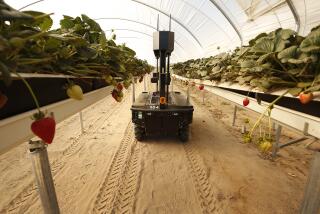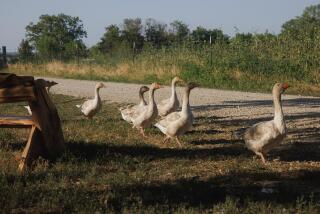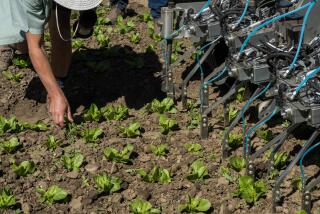COLUMN ONE : Farming’s Exodus of the Young : The ‘80s crisis is over, but the turmoil took a toll on youth. Many are seeking other careers in a trend that could hasten the ongoing decline of family enterprises.
VINTON, Iowa — Like his father before him and his father’s father, too, Jason Hartz grew up on a farm. Hogs, corn and soybeans are in his blood. Still, in a few weeks he’s heading off to college in North Dakota to learn how to be an aerospace engineer.
It’s not that Hartz, 18, doesn’t like farming or wouldn’t someday like to take over his dad’s 1,000-acre spread here in Benton County. He would. He just doesn’t see much future in it.
“My dad puts all those hours in every day and what’s he get out of it?” Hartz asked, quickly supplying his own response. “Not what he deserves.”
Conventional wisdom says the farm crisis of the 1980s is over and good riddance. But there is growing evidence that it so radically altered the economic realities for farmers while scarring the youth who lived through it that a farm crisis of a different sort could be in the offing in years to come.
In short, the next generation of would-be farmers, the Jason Hartzes of rural America, are abandoning the land in droves. The ranks of farmers have been thinning for decades as technology replaced manpower needs and the rural population became more educated and sophisticated. But some experts warn that what had been a steady, gradual erosion could turn into a free fall as the vast majority of rural youth opt not to follow in their fathers’ footsteps.
That might not imperil the nation’s food supply, since American agriculture is getting ever more efficient and simply doesn’t need as many people as it once did to work the land. It could, however, hasten the demise of the traditional family farm, undermine what’s left of the small-town heritage and ethic which Americans hold dear, and heighten environmental concerns over dependence on pesticides and fertilizers which tends to increase as farm operations get larger,
“You’re going to see that shortly after the turn-of-the-century we’re going to have plummeting farm numbers,” predicted Paul Lasley, a rural sociologist at Iowa State University. “ . . . One of the real important issues for society is who is going to be the next generation of farmers.”
Evidence of the trend, both statistical and anecdotal, is overwhelming. Not only has enrollment in agricultural colleges fallen substantially over the last few decades, but the vast majority of graduates go into agribusiness, plant science and other careers related to food processing and development where opportunities are growing and regular paychecks are secure. The percentage that actually takes their skills back to the farm can be counted in single digits.
Youth programs like 4-H and the National Future Farmers of America, long aimed at teaching young people how to farm, have shifted emphasis to other goals and moved into towns and cities to compensate for a significant membership drop among farm youth. The Future Farmers group has even changed its name to simply FFA, turning what used to be only an abbreviation into an official title, and has branched off into such programs as natural resources management and landscaping.
Perhaps the official government numbers provide the most vivid proof that farming is getting disturbingly long in the tooth, with fewer younger people coming along to replace the retirees.
The number of American farms has steadily dropped from a high of 6.4 million in 1920 to around 5.4 million in 1950 to just under 2.1 million by 1987 when the most recent U.S. Census of Agriculture was taken. In a 1986 study, the Office of Technology Assessment, an arm of Congress, predicted that the nation’s roster of farms would slip to a mere 1.2 million by the year 2000 if present trends continue.
Dissecting those 1987 census totals, the average age of active farmers had risen to 52, while the number of farmers under the age of 25 dropped 43% in just five years and the number between the ages of 25 and 34 fell 17% during the same time frame. Only about 1% were under 25 while nearly 30% were over 55 years of age. What’s more, there were nearly as many active farmers 70 or older as there were those 34 or younger.
Other significant side notes from government data: The Agriculture Department’s Economic Research Service has concluded that, contrary to popular belief, the drop in farm numbers during the heart of the ‘80’s crisis decade was primarily due not to farm failures and bankruptcies but rather the falloff in new farmers trying to get into the business.
“What it all adds up to is (more) shriveling of the rural community,” warned Marty Strange, director of the Nebraska-based Center for Rural Affairs. “It means an atrophying of Main Street. What rural communities live on is not commodities. Rural communities live on rural people. If you don’t have people out there populating the land, you’re not going to have small towns.”
Not everyone, to be sure, has such an apocalyptic view of the demographics. Dick Retz, who oversees start-up farm loans for a large Cedar Rapids, Iowa, bank, agrees that fewer farmers means a greater concentration of land in the hands of the corporate and private farmers who remain.
But that, argues Retz, is merely agriculture’s way of responding to changing markets and technology, much as the shakeouts which the auto, steel and other industries have endured in adapting to their altered economic environments. “This is the capitalist system,” says Retz. “ . . . It’s all a struggle to acquire a competitive edge. It’s not bad or good. That’s just the way it is.”
Agreed Arlington, Va.,-based agricultural economist James Holt: “I don’t think there is a serious problem as to whether there are enough people, rather I think it is the other way around. Technology made farmers redundant more rapidly than they moved off the farm.”
There’s an old adage in agriculture: The best way to get a farm is to either inherit it or marry into it. But even that time-honored way of passing the torch has, to some extent, become a victim of agriculture’s own success at growing things.
With profit margins thin and fickle as the weather, running a money-making farm these days takes an increasing measure of expertise and business savvy. But as machinery gets more sophisticated and more producers specialize in one or two crops rather than several, the job is nowhere near as physically taxing as it used to be.
In the past, the long hours and hard labor would literally wear out many a farmer by middle age and he needed a son or two to come along and take over the load. Nowadays, a farmer can harvest his fields from the air conditioned and shock-cushioned cab of a combine equipped with a stereo and a cellular phone. Oftentimes, dad is simply not ready to quit when the heirs are ready to take over, so they start some other career and never look back.
But a bigger discouragement is money. It just takes too much of it to get going. Stung by a flood of bad loans in the ‘80s, banks are increasingly gun-shy about extending credit, especially to young upstarts with few assets and no track record in an inherently risky business.
Many lending institutions require down payments of 40% or more on farm start-up loans. With good Iowa land averaging around $2,000 an acre, a newcomer would have to come up with $80,000 just to qualify for a pint-sized purchase of 100 acres, not to mention the tens of thousands of more dollars he would need to buy machinery, seed, fertilizer and, possibly, livestock.
“Eighty to 85% of our farmers are over the age of 50 and they can’t afford to get their sons started farming anywhere simply because it takes too much revenue,” said Marty Junge, who owns a farm chemical supply business in Van Horne, Iowa, about 25 miles west of Cedar Rapids. “ . . . It’s going to be a major problem down the road. Young guys just can’t get their hands on the money needed to take over the land.”
Charlie Ward is perhaps the exception that proves the rule. At 31, Ward and his wife, Peg, own a 40,000-hen egg hatchery and tend corn and beans on 250-acres, most of them rented, outside Van Horne. Getting there was a trick in itself.
Back in the early ‘80s, Ward worked with his father on 400 acres in nearby Coggon. Soon, the farm economy hit the skids and the acreage wasn’t enough to support more than one branch of the same family. He left to work in a factory in Cedar Rapids.
Eventually, Ward got the itch to return and learned of a place he could rent for $140,000. The problem was getting a loan. Three different bankers turned him down before Retz in Cedar Rapids took a chance despite Ward’s lack of significant assets or collateral. With that foot-in-the-door, plus some hard work and a little bit of luck, he earned enough to make a down payment on the place he now owns.
Still, out of a family of seven brothers and one sister, he’s the only one still in farming. One brother is in construction, another works for the state highway department, another manages a paint store, another works for a major agribusiness conglomerate and still another is majoring in business management in college. His sister married a computer manager and moved to Minnesota.
One reason none of the others stayed in farming, Ward thinks, was because they heard their father running it down so much. “The whole time we were growing up he was saying, ‘Boys, don’t farm,”’ Ward recalled. “ . . . It’s just not being encouraged anymore. The whole attitude towards farming got turned around and is so negative that nobody wants to get into it.”
That may be overstating the case a bit. But as Ronald Gomes, dean of the agriculture department at the University of Illinois pointed out, the reality of working the family farm isn’t necessarily as fulfilling as the romanticized version often portrayed in Hollywood.
Take a dairy farm. “The farmer, the farmer’s wife, the farmer’s family gets to milk those cows twice a day and feed them twice a day and scoop up (manure) . . . twice a day and all those good things 365 days a year,” said Gomes. “Christmas, Thanksgiving, no vacation, frequently a 12- to 14-hour day. And those people say, ‘look, I want something better for my kids.’ ”
Often, the signs start early that young people are turning off to agriculture. For example, Jason Hartz, the aspiring 18-year-old aerospace expert, had to switch 4-H clubs two years ago because the one he was in disbanded for lack of interest. But that was nothing compared to the slap of reality that hit Hartz last year when his father seriously burned an arm with chemical fertilizer and had to sell off the hogs to lighten the workload.
“There’s so many things that can go wrong in one year it can break you,” Hartz sighed the other day as he walked around the Benton County Fair, the first one he has attended since he was 10 years old where he didn’t have a hog to show in the livestock competition.
School programs are also suffering. Garth Beatty, a farmer who sits on the Vinton school board, said the vocational agriculture program for high-schoolers was merged with that of another school to keep it alive. Yet, it’s still a struggle to find enough interested students to justify the course.
Of all the teen-agers who have graduated from Vinton High in the last eight years, Beatty said he can think of only one who stayed on the farm. Indeed, his own children have either left or are planning to when they get old enough.
Dan, 24, was graduated from West Point last year and is starting a career in the Army. At 22, Matt is out of college and beginning work as an auditor for a big furniture maker. Nineteen-year-old Mark will study business management when he enters college in a few weeks and Sara, 15, says only that she wants to do something where she knows she can make a lot of money and farming’s not it.
“It seemed to me the return from the work just wasn’t worth the work itself,” Mark said in explaining his career decision.
Multiply the Beatty household by thousands of others just like it, and you’ve got the makings of a full blown exodus shaping up. “In the next 10 years there’s going to be quite a change,” predicted Garth, 50. “There’ll be a large number of people definitely done farming. Who’s going to take over this land? I don’t know.”
The last decade of agricultural upheaval--an era when both crop and land prices collapsed and those too young to recall the Great Depression got their first brush with economic failure and social pain--has proved a big turnoff to many rural youth.
At the University of Missouri, sociologists surveyed freshmen who entered the College of Agriculture in 1989 about their career plans. Of those who came from a farm background, 52% said they had at one time planned to make farming their occupation. But only 19% said they still did.
Asked to elaborate, one student wrote: “I am not afraid of hard work. However, working that hard and receiving so little does not appeal to me. . . . “
Said another: “I watched my dad put everything he had in our farm a few years back only to have a drought wipe out our crop and the bank got our farm. I was so deeply affected that I never want to go through something like that again.”
Faced by such developments, technology can do wonders to keep the fields ripe with grain even if fewer and fewer people are working to do it. Still, some analysts warn that the environment might suffer even if the stomachs and pocketbooks of consumers don’t.
The less labor-intensive farming gets, the more it must rely on chemical pesticides and fertilizers, explained Strange of the Center for Rural Affairs. “In the short term there’s mountains of corn but in the long term there’s polluted ground water, increased soil erosion and a lot of environmental problems that are the product of trying to have a technology substitute for human management and labor,” he said.
Such prospects are of deepening concern to many farm state lawmakers, among them Rep. Timothy J. Penny (D-Minn.) who is the chief sponsor of legislation to earmark a portion of government farm loans specifically for beginning farmers and ranchers.
Under the present setup, the Farmers Home Administration will help out with low interest loans to purchase property only after the farmer has come up with enough cash to meet a 30% down payment. That effectively freezes out many young farmers. Penny’s proposal would redirect loan money to cover a greater portion of the down payment.
“I’m concerned we are going to lose a generation in agriculture,” Penny said. “And if we don’t create opportunities for a new generation to buy the land the only alternative will be for established farmers to get larger and that will restructure agriculture irreversibly.”
Some farmers think it’s too late for a fix. “It’s all going to come down to corporate farms anyway,” said Darwin Meyer, 38, who tends 750 acres of corn and beans and 1,500 hogs near Van Horne. “Five to 10 years down the road and we’re going to end up working for somebody. I still wouldn’t trade it for nothing, though. I love to gamble. It’s just like shooting craps. It’s all one big roll of the dice.”
The Aging American Farmer
The average age of active farmers in the United States had risen from 50 in 1982 to 52 by 1987, according to the U.S. Census Bureau. The most drastic change in the period was a 43% decline in the number of farmers under age 25.
65 and Age in: Under 25 25-34 35-44 45-54 54-64 older 1978 66,575 285,420 433,900 549,159 582,175 370,546 1982 62,336 283,510 443,420 505,412 536,402 399,596 1987 35,851 242,688 411,153 454,910 495,814 447,341
More to Read
Inside the business of entertainment
The Wide Shot brings you news, analysis and insights on everything from streaming wars to production — and what it all means for the future.
You may occasionally receive promotional content from the Los Angeles Times.










